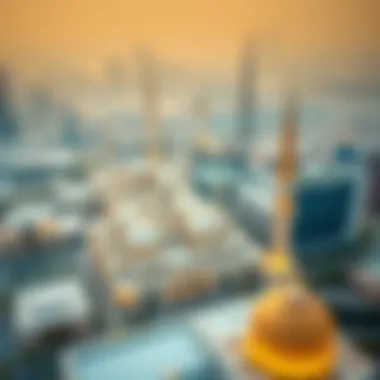Understanding the Significance of Dubai's Call to Prayer


Intro
The call to prayer, known as the adhan, is a profound auditory signal in Dubai, echoing across the skyline of this bustling metropolis. This call is not just about marking time; it encapsulates layers of cultural richness and historical significance. As this city evolves with vigor, blending modernity with tradition, the adhan emerges as a distinctive feature that influences both daily routines and social fabric.
In the diverse landscape that is Dubai, the adhan acts as a reminder—not merely to worship but to pause, reflect, and embrace community. The melodic call sweeps through the streets and boulevards, enticing both locals and visitors alike to appreciate the deeper narrative woven within this practice. More than just an announcement, it bridges geography, ethnicity, and lifestyles, fostering a sense of unity among varied populations.
In this article, we will explore various aspects surrounding the call to prayer within the context of Dubai, dissecting how its integration into modern life facilitates an ongoing dialogue between the old and the new. We will explore its architectural representation, dive into its cultural underpinnings, and analyze how it shapes the experience of living in such a dynamic city.
Being a melting pot, the nuances regarding the adhan reveal much about the socio-cultural dynamics of Dubai, and understanding these implications can guide potential investors, expatriates, and residents alike. From its historical roots to its modern embodiment in the skyline’s grand mosques, the call to prayer remains a significant part of the collective identity of this vibrant city.
Prelude to the Call to Prayer
The call to prayer, commonly referred to as the Adhan, is a deeply ingrained custom in Islamic culture and serves as a significant feature of life in Dubai. This vibrant city, known for its towering skyscrapers and luxurious lifestyle, holds the call to prayer as a sacred artifact that bridges its rich heritage with the modern era. Grasping the importance of the call to prayer in Dubai unveils not only the city's spiritual essence but also its cultural identity shaped by tradition and community.
Understanding the Adhan
The Adhan is much more than a simple announcement; it's a melodic invocation that ushers in moments of sacred reflection. Typically delivered from the minarets of mosques, the Adhan steers the daily rhythms of life for Muslims in Dubai. The call rings out five times a day, prompting the faithful to pause their activities and engage in prayer – a practice that goes beyond ritual into the realm of deep connection with the divine.
The Adhan features an extensive formula with phrases that praise Allah, proclaiming His greatness and inviting believers to come to prayer. Its intonation varies, depending on the muezzin’s style and the specific mosque. However, its essence remains unchanged: to remind individuals of their faith, their community, and their obligations.
Cultural Significance in Dubai
Dubai’s cosmopolitan tapestry shimmers with a blend of cultures, yet the call to prayer is a powerful symbol of unity among its residents. While the city attracts diverse expatriates and tourists, the Adhan acts as a unifying force, subtly weaving the fabric of daily life. Locals often regard the call not just as a signal for prayer, but as a soothing presence that punctuates the clamor of urban life.
The Adhan can evoke nostalgia and remembrance among long-term residents, often stirring sentiments of home. For newcomers and expatriates, the exposure to the Adhan can foster appreciation towards local customs, drawing admiration for a tradition that stands resilient against the tide of modernization. Furthermore, it reinforces a collective identity in a city that is rapidly evolving yet devoted to honoring its past.
As the call resonates across the city, it also ignites conversations about coexistence, tolerance, and the beauty of diversity. It encourages tourists and residents alike to respect and embrace the culture surrounding them, promoting a richer understanding of what it means to live in such a multifaceted society. In the heart of Dubai, the Adhan serves as a reminder that even amidst bustling lifestyles, the spiritual ties and cultural roots remain intact.
Historical Context of the Adhan
The historical narrative surrounding the Adhan, or call to prayer, isn’t just a recitation or tradition; it is a profound element in the Islamic faith, embodying the essence of community and spiritual connection. This section aims to shed light on how the Adhan has shaped, and been shaped by, the cultural and historical milieu of Dubai and the broader Islamic world. Understanding its roots and trajectory allows us to appreciate its presence in daily life.
Origins of the Practice
The origins of the Adhan trace back to the early days of Islam, specifically to the time of the Prophet Muhammad in the 7th century. Tradition holds that the concept of the Adhan was suggested by a companion of the Prophet, Abdullah ibn Zayd, who, after a vision, proposed the idea of a specific call to gather the community for prayers. Emphasizing communal worship, the Adhan serves as both a reminder of prayer and an invitation to come together.
Key Details about its Origins:
- The call was originally intended to be a practical means of assembly, rather than just a spiritual statement.
- The first person to formally give the call was Bilal ibn Rabah, a close companion of Muhammad and one of the earliest converts to Islam. His voice was described as powerful and rhythmic, making it a fitting choice for such an essential role.
- The words of the Adhan articulate fundamental aspects of Islamic belief, reiterating the oneness of God and the prophethood of Muhammad, making it a form of declaration that every Muslim can resonate with.


In Dubai, as in other Islamic cities, this practice has been engrained in the fabric of society for centuries, reminding residents of their spiritual duties against the backdrop of urban advancements.
Evolution over Time
As the sands of time slipped through the hourglass, the Adhan evolved, becoming more than just a practical summons; it morphed into a symbol of Islamic identity. From its humble beginnings, the Adhan today reflects the complexities of modernity alongside tradition. In Dubai, the growth and expansion of the city's skyline have mirrored changes to this spiritual practice.
Noteworthy Evolutions in the Adhan:
- Technological Integration: Advances over the years have facilitated the incorporation of sound systems in mosques, amplifying the call in urban landscapes that echo modern marvels.
- Cultural Adaptations: In a city like Dubai, which pulsates with a cosmopolitan vibe, the Adhan has also facilitated inter-cultural dialogues. Expat communities, while being diverse in their faiths, often discover respect for the call, symbolizing Dubai’s effort to bridge traditions.
- Artistic Representations: Over the years, the way the Adhan is performed has varied greatly—through vocal artistry, choreography in sound, and even adaptations in various media. This underscores the persisting relevance while paying homage to its rich heritage.
"The Adhan is not merely about calling to prayer; it illustrates how faith can coexist and even thrive amidst the bustling life of a modern city like Dubai."
In concluding this narrative, it’s clear that the historical context of the Adhan is indispensable for understanding its significance in today’s diverse society. Residents and visitors alike feel the call echoing through the maze of high-rises and leisure spaces, reminding everyone of a collective cultural and spiritual foundation.
Architectural Aspects of the Call to Prayer
The architectural elements related to the call to prayer, or Adhan, encompass both functionality and artistry, serving as a fundamental aspect of Islamic culture, particularly in a city like Dubai where modernity meets tradition. The role of architecture is not merely to provide aesthetic value but also to ensure that the call to prayer can be issued effectively, reaching the ears of worshippers within and outside the mosque. In Dubai, where the skyline is a blend of the opulent and the culturally significant, the presence of mosques becomes a canvas painted with history, innovation, and spiritual symbolism.
Design of Mosques in Dubai
Mosques in Dubai are often designed with an ornate flair, reflecting the rich heritage of Islamic architecture while integrating contemporary styles. Each mosque, from the grand Sheikh Zayed Grand Mosque to the quaint community mosques, often features minarets that soar towards the sky. These towering structures aren’t just impressive sights but are also functional; they help amplify the sound of the Adhan.
- Geometric Patterns and Calligraphy: Much of the decoration involves intricate geometric patterns and Arabic calligraphy, which not only beautify the spaces but also provide spiritual enlightenment. The designs often draw on historical architectural traditions while embracing modern techniques.
- Prayer Halls: The interior spaces are equally significant, designed to create an inviting atmosphere for the faithful. High ceilings and spacious prayer halls enhance acoustics, allowing the Adhan to resonate clearly throughout the space.
- Landscaping: Many mosques also incorporate landscaping that emphasizes tranquility, offering a peaceful environment for meditation and prayer. The gardens surrounding mosques often feature water features, symbolizing purification, and provide a serene backdrop against the mosque’s architectural detail.
- Lighting Elements: Modern mosques incorporate advanced lighting systems, highlighting their architectural beauty at night, which contributes to the overall sense of place for both residents and visitors.
Acoustic Considerations
When it comes to the sound of the Adhan, acoustics play a crucial role. Dubai mosques are designed with specific features to ensure that the call to prayer is not just heard but felt.
- Sound Projection: The strategic positioning of minarets and the use of materials that enhance sound projection are essential. Many modern mosques utilize sound systems to amplify the call, ensuring that it reaches further distances without distortion.
- Consideration of Surroundings: Acoustics must also take into account the urban environment. The blending of historical architecture with modern structures poses unique challenges, necessitating a thoughtful approach to minimize sound interference from traffic and city noise.
- Community Participation: In some neighborhoods, the decision to add or upgrade sound systems in mosques involves input from community members. This is crucial in maintaining the cultural significance of the Adhan and ensuring it resonates within the hearts of both locals and expatriates.
In Dubai, the architectural aspects of the call to prayer reflect a harmonious relationship between innovation and tradition, where each mosque stands as a testament to the city’s cultural identity.
As Dubai continues to evolve, the architectural considerations surrounding the Adhan adapt too, ensuring that this ancient tradition remains a prominent aspect of life in this bustling metropolis. Understanding these architectural elements not only sheds light on the cultural fabric of Dubai but also highlights how the past intertwines seamlessly with the present, offering insights into the design ethos that governs the city’s buildings.
Frequency and Timing of the Adhan
The call to prayer, known as Adhan, is deeply imbued in the daily rhythms of life in Dubai. Understanding its frequency and timing provides crucial insight not only into the spiritual practices of the Muslim community but also into the social fabric of the city itself. The timing of the Adhan is more than just a sound; it plays an integral role in shaping daily routines, fostering community bonds, and narrating the nuances of life in a bustling metropolis where modernity meets tradition.
Daily Rituals
Daily rituals comprise the backbone of the Adhan’s significance in everyday life. The Adhan is called five times a day, marking specific points for prayer: at dawn, midday, mid-afternoon, sunset, and evening. This structured timing ensures that the faithful pause from their daily activities to reconnect with their spiritual selves. It forms an orchestrated pause in a city that rarely sleeps, allowing for a unique rhythm that marries worship with the fast-paced environment of urban life.


When the FAITHFUL hear the Adhan, it often serves as a reminder to gather thoughts and intentions. For residents, each call can momentarily transform the scene. Streets fill with a sense of gentle stillness; conversations quiet down, even in cafes buzzing with expatriates. This collective acknowledgment fosters a sense of community, uniting not just Muslims but drawing respect from visitors who witness such a profound cultural expression.
The morning Adhan is particularly noteworthy. It heralds the start of the day and, for many, acts as a cue to rise and shake off the night. The echo of the mu'adhin (the person who calls to prayer) becomes a constant companion in the background of daily life, steering the rhythm that many residents learn to appreciate.
Special Occasions
The Adhan also finds itself uniquely positioned during special occasions, amplifying its role during significant events such as Ramadan and Eid celebrations. During Ramadan, the Adhan not only signals the times for prayer but also indicates the start and end of daily fasting. The evening Adhan during this holy month carries heightened emotional resonance, often accompanied by communal gatherings to break the fast, known as Iftar. Here, the call transcends religious observance; it becomes a social event.
Eid al-Fitr and Eid al-Adha celebrations further illustrate the specialness of the Adhan. On these days, the call is often embellished with enthusiasm, as families unite in celebration, emphasizing their spiritual ties. It serves as a layer enriching the holiday atmosphere, reminding everyone to partake in communal prayers and joy. In these moments, tourists and expatriates find themselves embraced by the vibrancy and cultural essence of Dubai, often tryning it with the local customs that amplify the Adhan’s significance.
The Adhan intertwines the spiritual, cultural, and social threads of Dubai, enriching the city’s ambiance while fostering a unique sense of community.
Social Impact of the Adhan on Residents
The call to prayer, known as the Adhan, reverberates through the vibrant streets of Dubai, instilling a sense of identity and community among its residents. This ancient tradition not only serves as a spiritual reminder but also plays a crucial role in shaping social dynamics within the ever-evolving metropolis.
Role in Community Cohesion
In a city as eclectic as Dubai, where East meets West, the Adhan acts as an invisible thread weaving together a diverse population. For many locals, the harmonious sound of the Adhan at designated prayer times fosters a sense of belonging and togetherness. It's a ritual that creates a collective rhythm in daily life.
- The resonance of the Adhan resonates beyond mere sound; it becomes a touchstone for community interactions.
- Locals often greet each other during prayer times, exchanging smiles or nods, thereby strengthening social bonds.
- Events like community iftars during Ramadan bring both Emiratis and expatriates together, emphasizing solidarity during this reflective time.
Tourism and the Call to Prayer
Tourism in Dubai intertwines deeply with the cultural and religious tapestry of the city. The call to prayer, known as Adhan, resonates throughout this vibrant metropolis, reminding us that every corner of Dubai is imbued with tradition. For visitors, recognizing and respecting this practice offers more than just a trip down a cultural lane; it presents profound opportunities for genuine engagement with local life. The Adhan, echoing from the minarets, not only serves as a spiritual announcement but also frames the social landscape, creating unique experiences for tourists and fostering deeper connections with residents.
The tourists who venture into Dubai's bustling streets find themselves enveloped by the sounds of the Adhan, especially at the five daily prayer times. For many, these moments offer a striking juxtaposition to the glossy, modern surroundings of the city's skyscrapers and luxury malls. One notable benefit for tourism is that it encourages visitors to partake in local customs, engage with the diverse populace, and witness first-hand the coexistence of ultra-modern lifestyle alongside deep-rooted traditions.
Experiences for Tourists
When tourists visit Dubai around the times of the Adhan, they can experience a slice of authentic culture that’s hard to come by in other global cities. Allowing oneself to pause during these calls opens up a window into the daily lives of locals, giving a sense of belonging and appreciation for shared moments, even amongst strangers.
Here are some experiences tourists might cherish:
- Participating in Evening Prayers: Some mosques welcome visitors to observe or even join in the prayers, allowing tourists to engage deeply with the local community. The Sheikh Zayed Grand Mosque in Abu Dhabi is a prime example of this opportunity, though a short trip from Dubai.
- Experiencing the Call’s Sound: Certain areas in the city, like Dubai Marina or Jumeirah Beach, offer an almost surreal backdrop of sea and skyline while the Adhan wafts through the air. It creates a serene environment that invites tourists to reflect on their adventures.
- Cultural Tours: Various guided tours include the Adhan in their narratives, explaining its significance, and showcasing how it shapes daily life for Muslims in Dubai.
- Culinary Experiences: Some local restaurants and cafes strategically time their dining services to coincide with the end of the call, providing meal options that are culturally relevant and immersed in local customs. This can enrich a tourist's culinary journey and provide context to the eating habits post-prayer.
Understanding Local Customs and Etiquette
Navigating the cultural waters as a tourist in Dubai requires a degree of sensitivity and understanding, especially concerning religious practices. Observing the call to prayer is among the rituals that necessitate respect and awareness.
Visitors should consider the following etiquettes:


- Respectful Silence: When the Adhan is heard, it’s customary to pause conversations and allow reverence for the moment. This respect is not just for the call itself but for the people responding to it.
- Timing Activities: If scheduling tours or activities, particularly those around prayer times, be mindful that many shops and restaurants close briefly during the prayers. This could affect plans but is a small price to pay for genuine cultural appreciation.
- Dress Appropriately: While not specific to the Adhan, adhering to modest dress codes is key when engaging in religious spaces. This shows respect to the culture and customs.
- Ask Questions: Many locals appreciate genuine curiosity. Engaging in conversation about customs around the Adhan invites meaningful exchanges and fosters goodwill between visitors and residents.
Ultimately, understanding the role of the Adhan in the fabric of life in Dubai provides invaluable insights for tourists, enriching their travel experience while fostering an atmosphere of mutual respect and appreciation.
"To truly appreciate a culture, one must immerse themselves in its nuances, and the call to prayer is one of the most profound expressions of life in Dubai."
Resources for Further Exploration
Modern Adaptations of the Adhan
In today's fast-paced world, the call to prayer, or Adhan, has not remained static. It has undergone notable adaptations to resonate with contemporary society in Dubai. This section discusses the importance of these changes, how technology has transformed the way the Adhan is conveyed, and the influence of cultural exchanges and globalization on this venerable tradition.
Role of Technology
Modernization has crept into every crevice of our lives, and the Adhan is no exception. In Dubai, technology has played a crucial role in maintaining the tradition while adapting it for today's digital age.
- Mobile Applications: In recent years, smartphone apps have become popular among both residents and visitors wanting to stay in sync with prayer times. Apps such as IslamicFinder and Muslim Pro send notifications about prayer timings, including the Adhan. These tools offer a personalized way for individuals to connect with their faith.
- Sound Systems: The architectural evolution of mosques in Dubai now often includes enhanced sound systems. These systems ensure that the melodious voice of the muezzin reaches a broader audience without losing clarity.
- Social Media Platforms: Architecture is not the only area where technology has made its mark; social media also plays a role. Clips and live streams of the Adhan can be found on platforms like Facebook and Instagram, allowing a wider audience, including the global diaspora, to experience its resonance.
The blend of tradition and technology creates an environment where the call to prayer remains relevant while offering ease to those engaged.
Cultural Exchanges and Globalization
The fusion of cultures is a hallmark of Dubai, making it a melting pot of traditions, beliefs, and ideas. With expatriates from various backgrounds residing in Dubai, the manner in which the Adhan is perceived and practiced has also evolved.
- Multicultural Influence: As Dubai attracts individuals from various corners of the globe, the Adhan now evokes a sense of curiosity among newcomers. Many expatriates share their understanding and respect for the practice, further enriching its cultural tapestry.
- Adaptation in Presentation: The sound of the Adhan may also vary slightly based on regional influences. As a result, one might hear different melodic interpretations depending on where the muezzin is from, showcasing a delightful variety that emphasizes the universality of the call.
- Educational Programs: Institutions within Dubai often introduce programs aimed at educating foreigners about the cultural significance of the Adhan, emphasizing its role not just in Islam but in fostering community values. This educational outreach fosters understanding, respect, and appreciation.
"The Adhan symbolizes unity and diversity; it tells us that even amidst our differences, we can find common grounds through shared values."
Together, these adaptations allow the Adhan to not only survive but thrive in the context of a bustling metropolis, ensuring that while tradition is preserved, it can also adapt to the needs and sensibilities of a modern world.
Finale: The Adhan in Contemporary Dubai
The Adhan holds a unique place in the fabric of Dubai, weaving together a rich tapestry of culture, community, and faith. It serves as more than just a call for prayer; it’s a reminder of the city’s roots and its evolution amidst modernization. As each call echoes in the bustling streets, it underscores the juxtaposition of time-honored traditions and the cosmopolitan nature of its population.
Continuing Relevance
The significance of the Adhan continues to resonate in contemporary Dubai. Locals and expatriates alike find a rhythm in their daily routines marked by the five prayer times. For many, the melodic tones are a cue to momentarily pause, reflect, and engage in spiritual practices, fostering a sense of belonging. Inclusivity is key in this multifaceted city. The sound of the Adhan often acts as a bridge between communities, allowing for shared understanding and respect among those from varied backgrounds. Visitors may find it an enlightening experience, as they witness residents respond to the reverberations with reverence and routine. This illustrates not only a dedication to traditions but a living testament to the cultural pluralism characteristic of Dubai.
Future Perspectives
Looking ahead, the Adhan’s place in Dubai’s skyline is likely to evolve further. As technological advancements take root, there could be innovative ways to experience the Adhan, whether through augmented reality or sound installations that allow global audiences to engage with this aspect of Islamic culture from anywhere. However, as the city progresses, it is crucial not to lose sight of the essence of the call to prayer, which serves as a cultural anchor in a rapidly changing society. The balance between modernization and tradition must be stewarded with thoughtful consideration, ensuring that the Adhan remains a profoundly meaningful part of not just the skyline, but of daily life.
"The Adhan, with its profound simplicity, is a reminder that spirituality transcends geographical and cultural divides."
As Dubai navigates its future, the Adhan will likely continue to inspire dialogues around faith, community, and identity. In this ever-evolving landscape, the future of the Adhan is not merely about sound; it’s about the stories and connections it fosters across the city and beyond.







